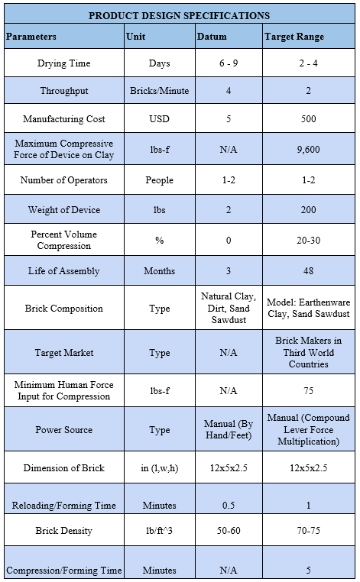At the beginning of the design phase, it is important to enumerate the exact customer requirements that your design must satisfy. The Product Design Specification tool, or PDS, is a tool that is frequently used in industry product design, and what I used to collect customer expectations of our design in my senior design project [3]. The PDS allows your team to define quantitative requirements of your individual conceptual designs. This is accomplished by establishing metrics for each customer need, attaching units to each need, and numerically evaluating as a team how each concept performs.
Table 1 shows an example of the PDS tool as used in my senior design process, and how our team compared our conceptual clay press design to the existing wooden frame used for clay brick formation in Nicaragua. Formulating this table was crucial at the beginning of the design process not just to collect metrics for our design-- we also wanted to make sure we were respecting our customer’s right to voice his expectations for the design. Moreover, we were able to understand what metrics our device should achieve to create value in owning and implementing the design in the community.

Table 1: The Product Design Specification tool table, used to compare our conceptual design for the clay brick press to the wooden clay mold used by the community in Nicaragua. Notice that units can be adjusted to compare non-numerical specifications as well.
As your team interviews potential customers and conducts research on existing products or processes that your design is looking to improve upon, it is important to collect specific numerical requirements that your design must meet to be considered a viable and competitive product.
Using the Product Specification Design Tool
- Research product design specifications (specs sheets) of competing/pre-existing design solutions and processes.
- Make a list of design requirements that you and your team seek to meet with your design.
- Choose a sample size of people who would use or want to use your product to interview (roughly 3-10 people).
- Consolidate a list of the features that are identified as important to your design. Ask a series of questions to determine numerical requirements of those features, and any other features suggested by the customer.
- Take each feature and ascribe a metric and unit to each (e.g, RAM in kilobytes, time in seconds, power in watts, soil density in kg/m3). If there is no numeric metric for the unit, list as “type”.
- Establish a datum, or baseline of comparison. This can be an existing product or process that accomplishes the tasks that your design is looking to improve. If no pre-existing technological solution exists, quantify a datum based on how it is done by hand.
- For each requirement, quantify to what extent the datum fulfills each consumer requirement. .
- For each conceptual design, quantify to what extent it does/will be able to fulfill each consumer requirement.
- Review the PDS tool and identify where the concept is “better” than the datum (e.g, higher efficiency, goes faster, stores more memory, has a higher load capacity). More does NOT always mean better. (e.g. takes less time, weighs less, costs less, takes up less space).
- Identify which aspects of the design should be revisited and optimized.
Personal Link
While many disciplines may work together to create a design solution, different areas of the project may require each discipline to individually consider what specifications must be met on their end of product design. As a mechanical engineer, I was asked to produce a clay press that could effectively produce more clay bricks in less time as compared to the community’s current device for brick production which was a simple wooden mold.
Some of the questions that we had to ask in designing our press to fit our customer’s needs were:
- How much is produced? (Throughput)
- How fast? (Time taken, user convenience)
- How many steps are required to operate the device for one cycle? (User interface simplicity)
- How much force/torque does the device require/output? (Force input/output requirements)
- How much power is needed/generated by the device in operation? (Energy requirements)
- How heavy is the device? (Mobility, safety)
- How many people are needed to operate the device? (Workers efficiency)
- How big/small can the device be? (Mobility, storage, portability)
- How expensive is the device? (Reduced price/costs)
- How long does it last? (Product longevity, need for maintenance/replacement).
Reference:
[3] “Appropriate Technology: What Is Appropriate Technology?” Pachamama Alliance, Pachamama Alliance, www.pachamama.org/appropriate-technology.
